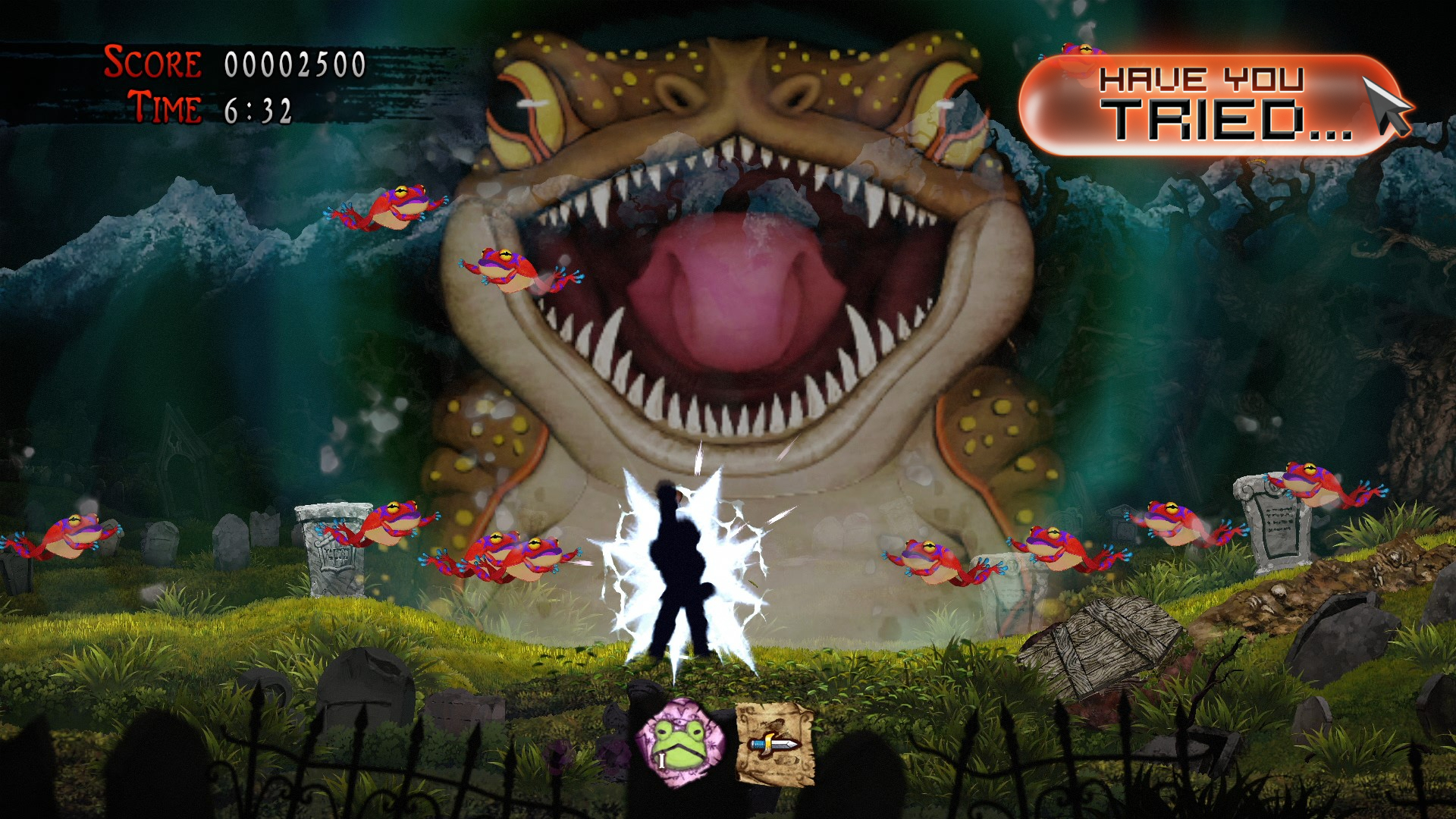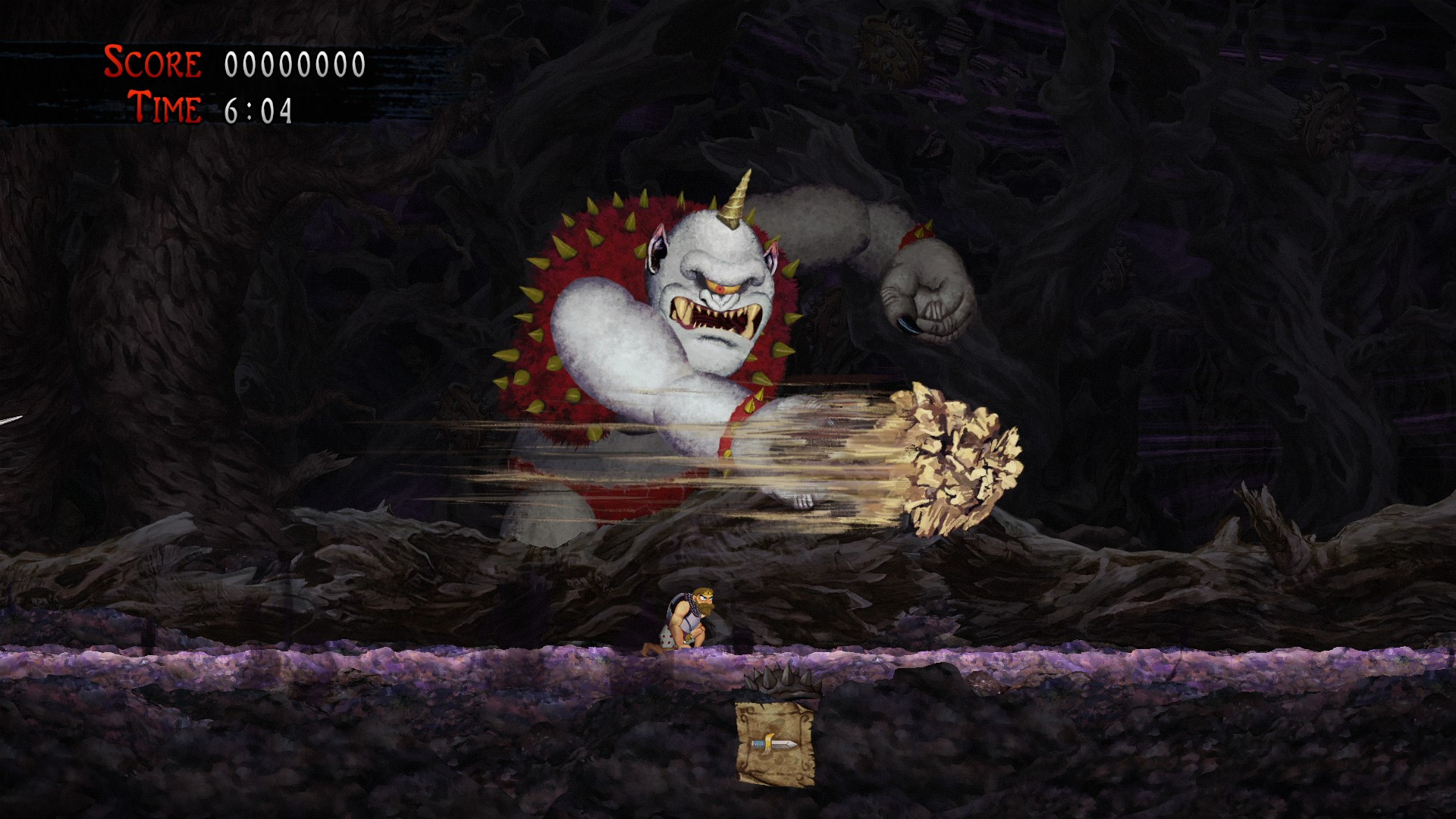Have you tried... seeing how your arcade skills have aged with Ghosts 'n Goblins Resurrection?
Why Capcom's latest reboot is a deadly theatrical farce

Ghosts 'n Goblins Resurrection tempts you to jump straight in at the deep end. "Make ready, for this is Ghosts 'n Goblins!" reads the descriptive text beneath ‘Legend’ mode on its difficulty select screen. This is bait for someone like me, coming to Capcom’s revamp of their 80s action platform series some 30 years after playing the originals. For those of us who’ve faced down its infamous reputation before, of course we want the full experience. Of course I want to know if my middle-aged self still has what it takes.
But like so many things in Resurrection, it’s a trick. I don’t mind – the old Ghosts 'n Goblins and its sequel Ghouls 'n Ghosts were always full of cunning ruses. It’s part of the appeal that you fall foul of their audacious layouts and relentless demons, laugh at your own misfortune, then earn a grin of pride as you learn to outfox them. It’s a bold and exhilarating approach. I just didn’t expect it to start on the options screen.
Ghost busters
After half an hour of painful inching progress, I’d barely reached the mid-stage checkpoint on the first level and was ready to give up. Perhaps I’d really lost my skills. Who doesn’t get a bit slower over three decades? But hang on. The original games were never that hard, were they?
Fortunately, Capcom has also recently released their Arcade Stadium collection, featuring both Ghosts 'n Goblins and Ghouls 'n Ghosts, so I was able to check. The contrast is night and day. In the opening level of Ghouls, skeleton enemies emerge in twos or threes and amble towards you. In Resurrection, they erupt in hordes, sprint at full tilt, and rail you towards the jaws of iron snap-traps. The first boss used to obligingly explode after a volley of lances to the face. In his re-imagined form he’s a multi-phase mega beast who brings along a friend to help him out.
Legend mode isn’t the Ghosts 'n Goblins of old. Don’t believe its lies. True, it does replicate the originals’ stingy checkpoint system, and the fact that protagonist Arthur is never more than two small mistakes away from death. One hit knocks off his armor, leaving him jogging in his boxers, completely vulnerable to the next attack. Yet that structure in Resurrection (although it does add an extra checkpoint just before each boss) is far more punishing because levels are longer, busier, and more exacting.

Thankfully, Resurrection isn’t so crass as to force all these headaches on you, because beneath the tough façade lies a work of supreme retro-artistry. And it’s too smart to let that go to waste. Drop down from Legend mode, and three lower difficulty choices progressively dial down the onslaught, scatter in more checkpoints and make Arthur’s armor a little less fragile. Not that it’s ever easy. Even on ‘Squire’ difficulty (Normal, in effect), there are many more hazards than you’ll find in the original games. But (for me) it’s the perfect way to appreciate the devil of Resurrection’s design without being worn down by its strictest rules.
The key to Ghosts 'n Goblins isn’t puritanically ascetic systems, but demonic mischief and chaos.
And that’s this new game’s secret – it works because it remembers that the key to Ghosts 'n Goblins isn’t puritanically ascetic systems, but demonic mischief and chaos. Its intricate levels aren’t so much grueling obstacle courses as a series of practical jokes, coherent with a theme that pits Arthur against corrupted crows, dastardly wizards, and scheming imps. Yes, a lot of the challenge is in learning patterns, but they never quite settle. Some enemies always materialize where it’s most inconvenient, often right under your feet, throwing you back into panicked improvisation.
Weekly digests, tales from the communities you love, and more
It’s like the real ghosts and goblins aren’t the creatures on screen, but a childishly malevolent presence just behind the scenes, pulling levers to drop a gravestone on your head or make a log flip you into deadly water before you can leap to safety. This feeling is smartly heightened in Resurrection, with its painted scenery, its paper cut-out characters that dance around on invisible strings, its cheeky spooky soundtrack. The whole thing feels like a haunted theatrical farce.
Revenge of the arremeredit
The series has always had this edge, even back when the technology wasn’t amenable to throwing so many props and puppets around. Nothing sums up its mentality better than the infuriating red arremeredit enemies in the first game, hovering red devils that somehow dodge your attacks before charging to knock you over. They’re back, of course, but Resurrection is more devious besides, smashing and spinning and ganging up on you at every turn. That’s its beauty, and it deserves applause for letting its irrepressible naughtiness run riot.
Because, for all the talk of difficulty, what really stands out in Resurrection is how uniquely memorable each individual sequence is. One of its smartest moves is sticking to a basic suite of player actions – run, jump, shoot. Sure, there are magic powers to unlock by collecting hidden ‘umbral bees’ dotted about each level, but these are completely optional. The onus is always on the shape and content of the levels to inject variety, and they absolutely do.
A new area isn’t merely a challenge, it’s a distinct challenge, the next episode in a fantastical journey. Arthur might one day regale his children with the tale of the time he withstood the storm of bouncing fire foxes or survived a demon-filled cave lit only by giant candles that he had to extinguish to create safe passage. In every scene, not only are there mobs of monsters buzzing or stomping around for you to fight off, but also a flux and flow of rotating, collapsing, or disintegrating platforms, sudden weather changes, tumbling masonry, vertical switches, and shifts of pace.

Those familiar with the older games should equally appreciate how much Resurrection is having a ball expanding and remixing classic moments. In the beginning, you choose between two paths, the top route reimagining Ghosts n Goblins, the bottom paying homage to Ghouls n Ghosts. After two levels on each path they converge, with later stages blending references from each game cocktailed with new ideas. And it all transitions smoothly because control is neatly consistent. Arthur’s running pace is as agonizingly slow as ever, and his once-size jump forces you into risky commitments. Yet these are features rather than flaws, a solid base that allows you to instinctively tune in to the game’s demands and cut down on mistakes.
With all the playfulness, there are predictably a few misfires. In particular, a couple of dragon-riding sequences become a pain because they rob you of the reliable properties of solid ground. And plenty of other sections are still highly frustrating, simply because of their fiendish placement of trolls and traps. But once you know what you’re up against, the mountains never seem unclimbable.
So have I still got what it takes after 30 years? Perhaps not. I certainly don’t have the patience for sparse checkpoints these days, and as much as I enjoy a challenge, I’m fine leaving Legend mode to those with sharper reflexes. But if the measure is how much satisfaction I can still get from a game like this, then maybe I have it after all. Ghosts n Goblins Resurrection is a joy because it’s recreated with such careful craft and understanding. And because it knows that those old games weren’t loved just for being difficult, but because they were so wickedly inventive.
Ghosts 'n Goblins Resurrection is out now on Nintendo Switch.
Jon Bailes is a freelance games critic, author and social theorist. After completing a PhD in European Studies, he first wrote about games in his book Ideology and the Virtual City, and has since gone on to write features, reviews, and analysis for Edge, Washington Post, Wired, The Guardian, and many other publications. His gaming tastes were forged by old arcade games such as R-Type and classic JRPGs like Phantasy Star. These days he’s especially interested in games that tell stories in interesting ways, from Dark Souls to Celeste, or anything that offers something a little different.


